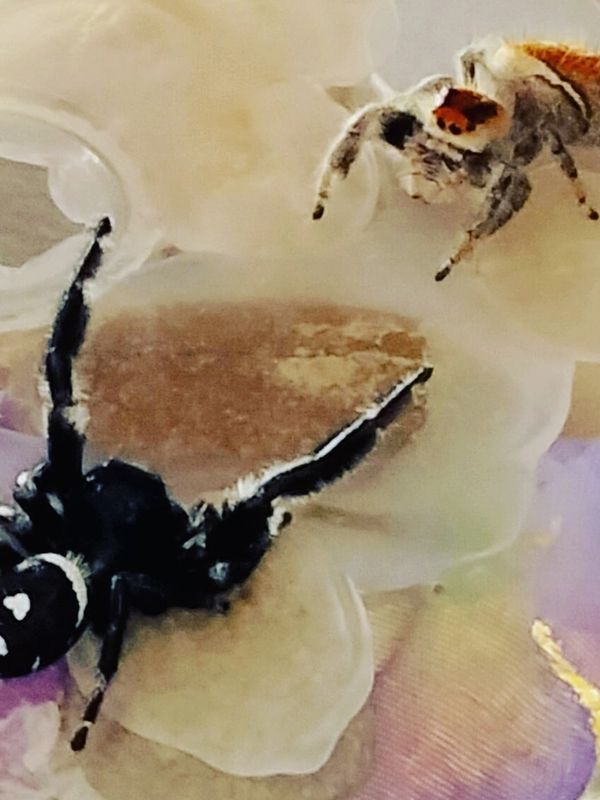Breeding Jumping Spiders Ethically
And so it begins...

We start out by pairing a male and female jumping spider of the same species from different bloodlines. Our pairing process takes weeks. It's almost as if our spoods court one another. Their enclosures are placed next to each other. Eventually they will show signs of chemistry and begin to communicate through movements. We synchronize their feeding schedules to make sure they are plenty full on the big day. On the perfect night, when the stars align, lol - they are well fed and active - they are introduced without barriers and the built up chemistry proves to be true as they successfully pair.
While spiders in the wild most likely have one night stands that don't end well, we like to take every precaution to make sure our pet spiders end up home safely after a night out on the town, if ya know what I mean. This is why we highly suggest building up chemistry between two captive bred spoods you may want to pair in the future.
Next come the babes :)

Our Mama's live in beautiful naturally decorated enclosures. We love to see the care that goes in to the homes they make for raising their young. We try to keep the breeding process as natural as we possibly can.
When our Mama's are comfy they will begin building a wonderful nursery for their sack. This will be unlike any hammock she's made before. It will be magnificent and have space for her little ones to crawl around inside. After about two weeks, the mama will begin webbing up a plump sack of baby jumping Spiderling eggs. It's the sweetest thing you've ever seen.
She will sit on her eggs, coating them with silk and protecting them from evil. It will be a couple of weeks before she even tries to venture out for food, when she does, we have a juicy waxworm ready for her.
From Sac to Wandering Babes
From Sac to Wandering Babes
From Sac to Wandering Babes

Mamas will stay with their young until they just can't take it anymore, literally. The sac will turn from a shade of pale yellow, to darker wiggly spoody babes, then to tiny black eight legged pups, adorable!
The Spiderlings will begin to roam around the nest while mom carefully watches. If she sees them trying to leave before it's time, she will quickly gather them back into the nest and close it.
Mamas are offered food once a week and the enclosure is misted every day. Eventually the slings will molt into their second Instar and will begin to leave the nest. Then, we offer the babes a few fruit flies every other day.
When mama literally can't take it anymore, she will leave the nest and watch her babes from afar. We will have her second enclosure ready for her and she will be gently relocated to an enclosure she has most likely made a hammock in and lived in before.
We patiently wait for mama to lay her next clutch while these babes continue to eat and grow in their home communally.
Going Our Separate Ways
From Sac to Wandering Babes
From Sac to Wandering Babes

We find that letting the slings grow together communally until L4/5, or until their fourth and fifth molts, results in healthier, happier spider pups. We also believe keeping their environments fun and engaging is also very important to optimal spider health.
Slings are kept in juvenile/sub adult sized enclosures in groups of ten to twenty until L4/5. The enclosures are decorated to mimic their natural environment. It is the absolute neatest thing to see them build hammocks all over the place, in flowers, behind leaves, etc.
At this stage, the slings are fed plenty of fruit flies each day. Before feeding, they are gently misted. As the slings come out to drink, if they have grown big enough, they are relocated into their own enclosure where they will get ready for adoption.
Time For Learning and Growth

Once slings have moved on up to their own enclosures we will begin to interact with them and get them used to one on one contact. They are usually quite skiddish at first, but after learning "the big human still brings me food here, too", they will mellow out and get comfy.
We monitor their eating habits and wait for them to build sturdy hammocks for their next molt. After they have grown to L5/6, we begin to offer them tiny mealworms and waxworms.
This is the most important time for our spooder pups. They are becoming accustomed to human interaction and we are making sure they grow to healthy and sturdy jumping spiders.
Finding Forever Homes

Growing a jumping spider takes a lot of time and love. It is usually about eight months from the day the mama lays the sac until the slings are ready to go to their forever homes.
By this time the babes have molted five to six times, been friendly with a giant human, and have graduated to larger prey. Their new owner is being sent pics of them and they are already being loved by a new family who is going to give them the best life possible.
If mama is done producing sacs, she is most likely hanging out in a decked out enclosure made strictly for her and her needs, and is being fed and treated like the queen she is.
